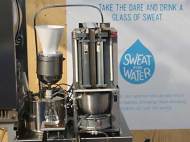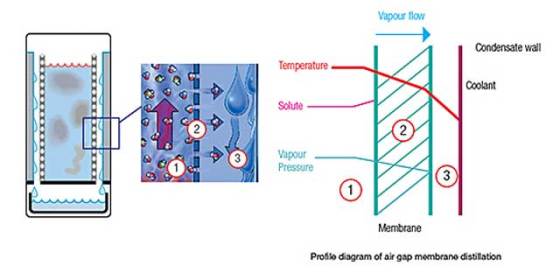Machine turns sweat into potable water
 Collaboration between Swedish engineer Andreas Hammar with researchers at the Royal Institute of Technology in Stockholm and the water purification company HVR resulted in development of the first machine that extracts people’s sweat from clothes, purifies it and transforms it into potable water. It uses a water purification technology called membrane distillation.
Collaboration between Swedish engineer Andreas Hammar with researchers at the Royal Institute of Technology in Stockholm and the water purification company HVR resulted in development of the first machine that extracts people’s sweat from clothes, purifies it and transforms it into potable water. It uses a water purification technology called membrane distillation.
The inspiration for the machine’s technology comes from the space travel industry, where every single drop of water is vital. The machine spins and heats the material to remove the sweat, and then passes the resulting liquid through a special membrane which allows only water molecules to pass through. This membrane keeps bacteria, salts, clothing fibers and other substances out. According to the researchers, the water extracted from the machine is actually cleaner than local tap water.
The primary component of the HVR’s membrane distillation process consists of a cassette holder with hydrophobic membranes, in which the water purification process takes place. The cassette holder is a plastic construction and a special technique is used to fit the membranes to the cassette holder. The process takes place at ambient pressure and at temperatures between 60 and 90°C (140 and 194°F).
Heated water circulates in the middle of the cassette between the two membranes. The other sides of the membranes are cold surfaces. The difference in vapor pressure between the hot and cold side and membrane design cause the unwanted material to be filtered while water molecules pass through. When the water molecules reach the cold side of the membranes, the molecules condense and the purified water runs down to a receptacle.
UNICEF is using the machine as a part of a campaign that draws attention to the fact that 780 million people in the world lack access to clean water. Everyday thousands of children die because of contagious water, lack of sanitation and poor hygiene practices. UNICEF works in more than 190 countries to put it right by improving water supplies and sanitation facilities and promoting safe hygiene practices.
UNICEF and Gothia Cup, an international youth tournament in football, are collaborating under the signature “United for children”, with focus on clean drinking water. Participants and visitors of this tournament were encouraged to contribute with their sweaty clothes. Two famous soccer players Tobias Hysén and Mohammed Ali Khan were the first to drink a glass of sweat during Gothia Cup. So far, researchers claim more than 1,000 people have sampled the water produced by the machine.
The amount of water the machine produces depends on how sweaty the person is, but one person’s T-shirt typically produces very small amount of water. So, the machine didn’t produce as much drinkable water as expected.
Even though the machine helped to raise awareness for UNICEF, due to its limitations, researchers didn’t believe that the machine will ever be commercially available. However, raised awareness could inspire other groups to develop a better version of the machine.










Is the effort worth it? In Developed countries(being cold mostly) hardly any sweating occurs and in Developing countries people wash their own clothes.
Dr.A.Jagadeesh Nellore(AP),India